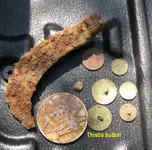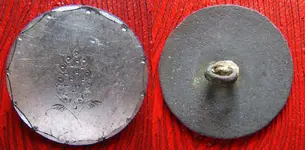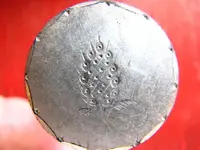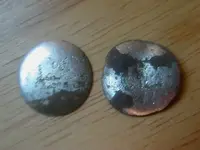Don in SJ
Silver Member
- Joined
- May 20, 2005
- Messages
- 4,937
- Reaction score
- 852
- Golden Thread
- 0
- Detector(s) used
- MINELAB SE Pro
- Primary Interest:
- All Treasure Hunting
In almost 30 years of "pingin", I have only ever found a few of the older buttons that were silver plated with a lot silver left, but I never found one from late 1700's early 1800's that had almost all of the silver plating left until yesterday.
I wish I had taken a good before cleaning photo, it would have really emphasized the need for thorough cleaning of buttons. I will say that when I found the four buttons yesterday at the same site I got that 3 in 1 coin at last week, I was none too thrilled about any of them by their initial appearance out of the ground.
When I got home I put all four into hot peroxide and then used Q-Tips to rub off the crud the best I could. Well one was pretty decent but since it was a Tombac, it was cracked and bulging, so not much eye appeal. The other two remained cruddy and heavily pockmarked with corrosion. However the fourth button, as I was rubbing with the wet Q-Tip, started to show some silver and a design in the center of the button. With that I put it back in more hot peroxide and let it clean a bit more on its own to loosen the remaining crud up some more.
About an hour later I took the button out and it seemed that the Q-tips were not really getting much more off and I thought I had another silver plated button that lost its plating on about 50% of the button, but since the design was so nice I decided to use Lemon Juice for the final cleaning and WOW, was I glad I did.
It took a bunch of rubbing, and soaking Lemon Juice on it but slowly the hardened black crust did come off the button revealing a beautiful design, including edge cutting and design.
I thought at first it was a Pineapple on the button, but that made no sense to me, so I then figured it was a variation of a Thistle, making it a Scottish themed button. Another individual told me he thought it was a Pineapple and he explained how the Pineapple back in the 1700's was a very highly prized fruit and was used in art, building ornaments, etc, and why not on a button.
I did some googling of Colonial Pineapple Motifs and I was surprised to see a very nice article on the Colonial Williamsburg website and now feel better about the design IF it is a Pineapple representation. I know it does not exactly match a Pineapple or a Thistle or a Pinecone, but I feel that it is supposed to be a Pineapple. I have sent the photo to the National Button Society and hope to get an opinion from someone there.
Either way, I think this is one of the most beautiful buttons I have found in quite some time and it will display nicely.
Oh, before I found the 4 buttons, I did walk some old roads for a couple miles in search of new sites, well, that kind of turned into a nice walk and that was about it, but I did get an oxen shoe, clad quarter and clad dime on the road and then I hit the 3 in 1 homestead before I called it a day hunting. So I do have pics of the finds before cleaning, just not a good closeup of the plated button. The silver plated button is 26mm in diameter.
Here is the website I found explaining about the role of the Pineapple in Colonial America.
http://www.history.org/christmas/dec_pineapple.cfm
Don
I wish I had taken a good before cleaning photo, it would have really emphasized the need for thorough cleaning of buttons. I will say that when I found the four buttons yesterday at the same site I got that 3 in 1 coin at last week, I was none too thrilled about any of them by their initial appearance out of the ground.
When I got home I put all four into hot peroxide and then used Q-Tips to rub off the crud the best I could. Well one was pretty decent but since it was a Tombac, it was cracked and bulging, so not much eye appeal. The other two remained cruddy and heavily pockmarked with corrosion. However the fourth button, as I was rubbing with the wet Q-Tip, started to show some silver and a design in the center of the button. With that I put it back in more hot peroxide and let it clean a bit more on its own to loosen the remaining crud up some more.
About an hour later I took the button out and it seemed that the Q-tips were not really getting much more off and I thought I had another silver plated button that lost its plating on about 50% of the button, but since the design was so nice I decided to use Lemon Juice for the final cleaning and WOW, was I glad I did.
It took a bunch of rubbing, and soaking Lemon Juice on it but slowly the hardened black crust did come off the button revealing a beautiful design, including edge cutting and design.
I thought at first it was a Pineapple on the button, but that made no sense to me, so I then figured it was a variation of a Thistle, making it a Scottish themed button. Another individual told me he thought it was a Pineapple and he explained how the Pineapple back in the 1700's was a very highly prized fruit and was used in art, building ornaments, etc, and why not on a button.
I did some googling of Colonial Pineapple Motifs and I was surprised to see a very nice article on the Colonial Williamsburg website and now feel better about the design IF it is a Pineapple representation. I know it does not exactly match a Pineapple or a Thistle or a Pinecone, but I feel that it is supposed to be a Pineapple. I have sent the photo to the National Button Society and hope to get an opinion from someone there.
Either way, I think this is one of the most beautiful buttons I have found in quite some time and it will display nicely.

Oh, before I found the 4 buttons, I did walk some old roads for a couple miles in search of new sites, well, that kind of turned into a nice walk and that was about it, but I did get an oxen shoe, clad quarter and clad dime on the road and then I hit the 3 in 1 homestead before I called it a day hunting. So I do have pics of the finds before cleaning, just not a good closeup of the plated button. The silver plated button is 26mm in diameter.
Here is the website I found explaining about the role of the Pineapple in Colonial America.
http://www.history.org/christmas/dec_pineapple.cfm
Don
Attachments
Upvote
0










![congratulationsgold[1].gif congratulationsgold[1].gif](https://www.treasurenet.com/data/attachments/167/167984-b9bcbc1d69cabd8037d8440558c0ea92.jpg?hash=uby8HWnKvY)
